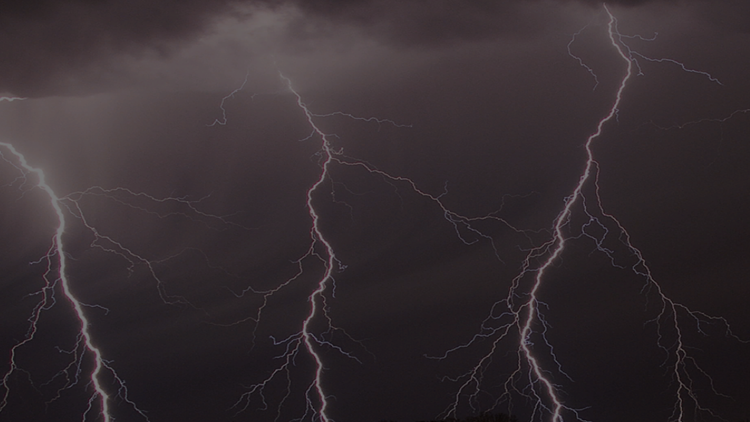WASHINGTON — It's a picture-perfect day and you are enjoying yourself outdoors. Perhaps you are swimming, biking, or enjoying a nice walk, when all of a sudden, a thunderstorm pops up. Most people will head indoors at this point, but how long should you wait to back outside after the storm passes? The National Weather Service recommends waiting at least 30 minutes until after a storm passes before resuming outdoor activities. Why? Because lightning can travel far.
Lightning Travels Far
You don't have to be under a thunderstorm to get struck by lightning. Lightning can strike 10 to 25 miles away from a storm. So even if it's not raining anymore, you can still get struck if a storm is nearby.
The world's longest lightning flash lit up the sky in 2020. The distance of the lightning bolt was a whopping 477 miles! The megaflash stretched from Texas to Mississippi on April 29, 2020. National Oceanic and Atmospheric Administration satellites captured the bolt and the record was certified by the World Meteorological Association.
That bolt beat the old record of 440.6 miles for a lightning strike across southern Brazil in 2018.
Too Hot To Handle
Getting struck by lightning is the last thing that you want to happen. Lightning bolts can get as hot as 50,000 degrees. That's five times hotter than the surface of the sun!
Tips
Here are some tips from the National Weather Service on how to stay safe when lightning rumbles.
- Don't use corded phones: Using a corded phone during a thunderstorm is one of the leading causes of indoor lightning injuries. However, it IS safe to use cordless or cell phones as long as they are not being charged.
- Stay away from windows and doors: Sitting on an open porch to watch a thunderstorm is also dangerous. It is best to be in an interior room during a thunderstorm.
- Don't touch electrical equipment or cords: Any device that uses electricity (e.g. computers, televisions, household appliances, etc.) is susceptible to a lightning strike. Electrical surges caused by lightning can damage electronics (even at some distance from the actual strike), and a typical surge protector will do little to protect the device (or the person using it) if lightning should strike. So consider unplugging certain appliances or electronics, but for your own safety do this BEFORE the storm arrives.
- Avoid plumbing: Metal plumbing and the water inside are both very good conductors of electricity. Therefore, do not wash your hands or dishes, take a shower or bath, do laundry, etc. during a thunderstorm.
- Refrain from touching concrete surfaces: Lightning can travel through the metal wires or bars in concrete walls and flooring, such as in the basement or garage.
- If inside a vehicle: Roll the windows up and avoid contact with any conducting paths leading to the outside of the vehicle (e.g. metal surfaces, ignition, portable electronic devices plugged in for charging, etc.).
Myths
Some people believe that rubber tires on a car will keep them safe from lightning. Actually, the metal on the car that's rerouting the electricity, is what keeps most people safe in their cars. Electricity travels around the car and to the ground. Even if rubber can limit the transfer of electricity, your tires are tennis shoes are no match to the power of a lightning bolt.
It is a myth that lightning never strikes the same place twice. Lightning in fact strikes the same place twice all the time. The Empire State Building is struck by lightning nearly 100 times each year. The Washington Monument has also been struck by lightning multiple times.



